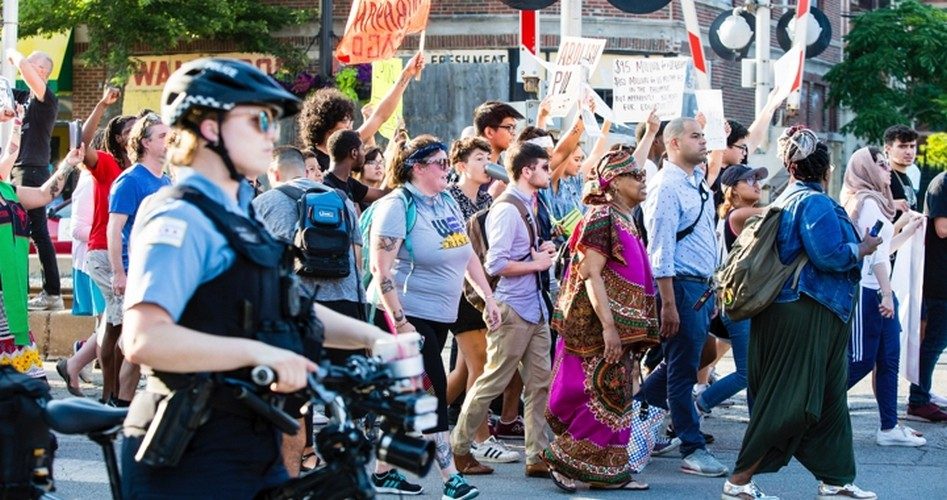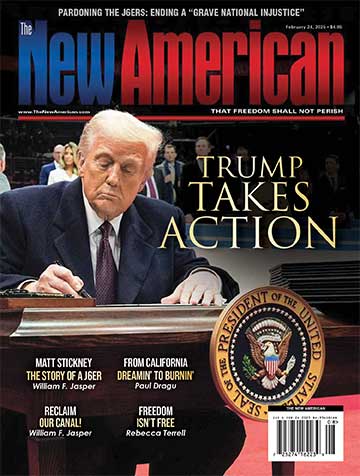
Violence erupted in Chicago this weekend after a rookie cop shot and killed a black man on July 14. Angry protestors demanded to know why a rookie cop shot 37-year-old Harith Augustus, and quickly gathered after the shooting to confront police.
Within 24 hours, the police department offered an answer. It released body-camera footage that shows Augustus doing what he shouldn’t have. Augustus was carrying a concealed firearm without a permit, and the officer fired on Augustus after he reached for the gun.
Protests continued Monday, however, as many residents demand more action from the police department.
What the Video Shows
The video, which does not include audio, shows a black officer speaking to Augustus and two white officers, one woman and one man, walking in front a fourth officer’s body camera, approaching from Augustus’ right.
As Augustus pulls his wallet from his back pocket to show the black officer his ID, the female officer puts her hand on her weapon. As the male officer circles behind Augustus, the female officer appears to reach for Augustus’ hip. He turns clockwise, and as she tries to grab his right arm, Augustus pulls away, and the officers swarm. Augustus breaks free.
A freeze frame clearly shows Augustus with a holstered pistol on his right hip and what appears to be an extra magazine on his left hip. Augustus flees into the street, puts his right hand on the gun as if he is trying to pull on the officers, and then gets shot by one of the officers. The officer who shot Augustus was a probationary cop with, according to the Chicago Tribune, “less than two years on the job.”
A police spokesman told the Chicago Sun-Times that Augustus had a license to own a firearm but not a concealed-carry permit.
The Protesters
City residents reacted immediately, the Sun-Times reported.
Protesters soon gathered to throw rocks and bottles — and even a bottle of urine — at police. Police responded by pushing their line of officers forward into the group of protesters, leading to bursts of fights that culminated in a violent episode near the end of the night. Officers were seen hitting demonstrators with batons as the crowd scattered through the parking lot of a nearby strip mall.
The protests continued Saturday night, with participants calling police “murderers,” the Sun-Times reported, and asking “who do you serve?” and “who do you protect?”
After an officer was hit with the urine and rock-pelting began, the police pulled batons to control the protesters.
According to the Chicago Tribune, “as officers tried to contain the crowd, some of them dragged people to the ground or struck them with batons. Other officers held batons over their heads to ward off people yelling at them.”
A woman in the crowd called the police “violent mother*******.”
Police cleared the area by about 10:30 p.m.
The rocks and bottles injured four officers and four demonstrators were arrested, the Tribune reported.
Video Released
The protest inspired the police to release body-cam footage much more quickly than in the past. On Sunday, Police Superintendent Eddie Johnson explained the decision:
In this particular instance after seeing what transpired last night, I have an obligation to this city, to the community and to these police officers to make sure this city is safe and calm. And last night after what I saw on video, you know, bottles being thrown, urine being thrown at the police officers, we can’t have another night like that.
But the city hasn’t always released footage so quickly. The city changed its policy after a white police officer shot Laqaun McDonald 16 times on October 20, 2014.
“Before McDonald’s fatal shooting,” the Tribune noted, “the city did not regularly release video of incidents at all.”
But in February 2016, “the city’s Police Accountability Task Force announced that audio and video recordings would be released within 60 days of a shooting or in-custody death. Law enforcement agencies can seek a 30-day delay in the release.”
Protests Continue
Even after the bodycam video was released, protests continued on Monday, with many people distrustful and demanding to know more about what happened. According to the local ABC7,
Hundreds of protesters turned out again Monday, taking over the same block of 71st Street where police shot and killed a man in the South Shore neighborhood on Saturday.
It’s been two days since 37-year-old Harith Augustus was shot and killed during a confrontation with Chicago police officers. An independent investigation into the shooting is underway, but several groups say they don’t trust it.
“I think that Mr. Augustus’ constitutional rights were violated,” said Maxwell Little, South Shore resident. “To weaponize somebody’s blackness is against the law.”
The Chicago Alliance Against Racism and Political Repression organized Monday’s rally (shown).
Maria Hernandez, an activist with Black Lives Matter, told ABC7, “We need to know who the officer was who actually did this and they need to be held accountable…. You can see that he has what looks like a wallet in his hand. He was trying to comply and he was shot in the middle of complying. Roughed up and shot.”
And Frank Chapman of the Chicago Alliance Against Racism and Political Oppression noted, “We have a right to protest. The police do not have a right to come out and brutalize us because we’re protesting. And that’s been their history, that’s what they’ve been doing…. We want these things investigated because we know that the police are not clean on these issues, that they have a dirty record.”
Protesters and activists are calling for all of the video of the shooting to be released, not just the brief clip released Sunday. Chicago’s Civilian Office of Police Accountability says all video will be released within 60 days, per their policy.
Chicago Violence
Whatever the end result of this shooting, Chicago, which has some of the tightest gun-control laws in the country, is a municipality beset by violence. It was the scene of 650 homicides in 2017, and thus far in 2018, 276.
The question is why Augustus tried to get away from police, and why he did what he should not have done: reach for his gun.
Photo: AP Images


